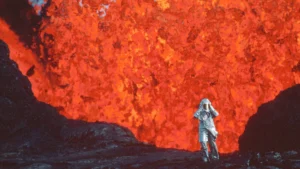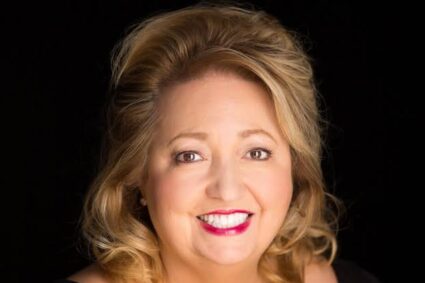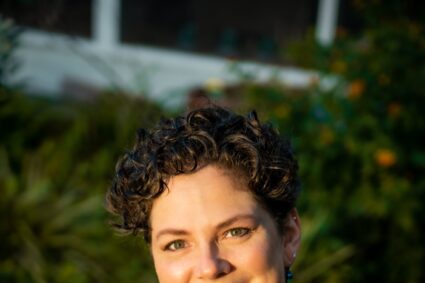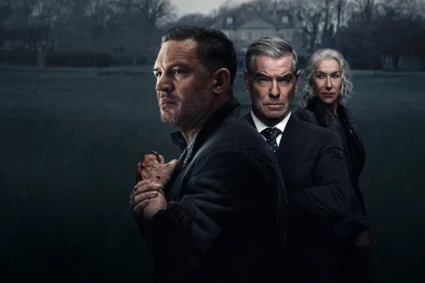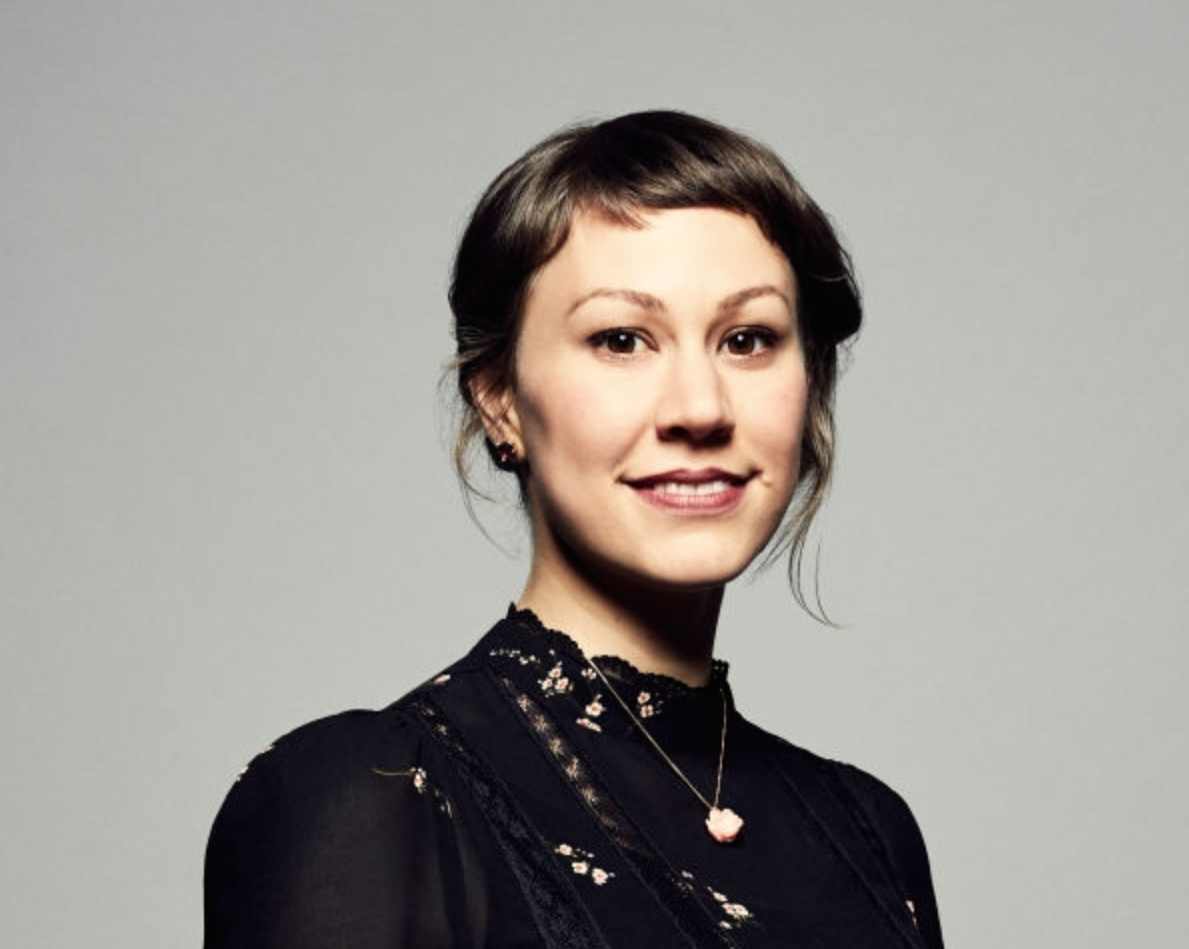
On this edition of the INTERVUE, I recently sat down with director Sara Dosa who tells a unique love triangle in the new documentary – “Fire of Love” – now playing in select theatres.
Intrepid scientists and lovers Katia and Maurice Krafft die in a volcanic explosion doing the very thing that brought them together, unravelling the mysteries of volcanoes by capturing some of nature’s most explosive imagery.
You’re welcome. So when did you realize that this was a love story? A possible love triangle between Katia, Maurice & volcanoes?
It was actually quite early on in our process that we wanted to tell a love story. And specifically, a love triangle, as you said, that was something that came from Maurice himself. We were reading one of his books, a book called “Questions for volcanologists” and he wrote a sentence in that book where he says, “For me, Katia and volcanoes,” it is a love story. And it was so clear that he was talking about three characters, there was a triangular relationship.
So that plus all kinds of other research we did, including talking to loved ones, colleagues, family members, it was so clear that love was what guided their lives. Their partnership, as well as their love for volcanoes led to this totally unique, passion and journey through the world. So that felt most true in terms of a story. And was incredibly exciting for us to get to play with. So that’s what kind of led to the development of Fire of Love in its final presentation.
Now, I understand that you went through two hundred hours of footage, how did you decide which footage to keep? And did you have various acts? Or cuts different lengths of the document before you landed on the official version that we see?
Yes, yeah, we using kind of the love triangle is a framework that helps focus our material down for sure. At the same time is so spectacular and beguiling all the time that that so we kept wanting to include more and more and more. We did kind of structure the film, like a love story, kind of the dreaminess of falling in love and the disillusionment that can come with finding out kind of he more complex harder sides or of the thing or person you fall in love with, ultimately, to try to reconcile in the end. That felt very true to Katia and Maurice’s story.
Also, it was a helpful guide for us in structuring the film that did focus our approach to whittling down the material, there really wasn’t much of Katia and Maurice together. And so that absolutely took priority, we tried to get them in their voices, them together on camera, them in the shot as much as possible. But because the archive is so limited, and because usually one of them was filming, it was very rare to have them both, but that absolutely structured our approach.
There’s so many there’s so many things, we left out so many wonderful details about their lives. I really believe you could make a hundred films based off of not just the footage they’re left behind, but their words, the memories that live on and their loved ones too.
Something tells me if this movie comes out on Blu-ray, you may have to make some special.
I would love that. That’d be great.
The narration is one of my favorite aspects, especially since it’s Miranda July, and it’s very poetic to the film, how did the narration play off on the images that we see not just the still images, but the footage that we got to see.
We actually the very, very beginning we had hoped it would just be Maurice and Katia’s own voices and own images telling the film, but because the archival material was so limited, we knew that if we were going to tell a character driven love story, we didn’t need another narrative vehicle to bring out their personalities, their philosophies, as well as their dynamics. And we thought narration could do that well. Katia and Maurice themselves are came of age during the French New Wave, and adopted many kinds of flourishes and styles of the French do even their own work.
For example, recent and cinematography. Maurice has that kind of Hallmark snap zooms and his cinematography, and catches writing kind of reminded us sometimes of like the bombastic voice of Truffaut and his films. So we kind of looked at French New Wave narrators, trying to kind of adopt some of that tone that we experienced and that helped kind of guide our approach. But we really wanted an economical who could make space for the vastness of the images and recent catches own voices to be heard first and foremost. We wanted a voice that felt curious and playful, that didn’t proclaim to have all the answers but instead could point out questions because we are so didn’t have all the answers.
We did our best to research but there’s so many things that we would never know since Katia and Maurice died thirty years before we ever made the film. We also wanted the narration to reflect kind of the searching quality of a scientist who’s trying to make sense of the mysteries of the world. And in our minds, Miranda July just has like absolute incredible curiosity and strength and whimsy and poetry, to her voice and everything that she brings all at once and so getting to work with her. She added such richness. She kind of elevated our intentions for the narration to a much higher degree and working with her and artists who I just absolutely revere, it was absolutely a dream come true.
Well, it’s definitely a dream come true and definitely shows in this film, which I understand that it premiered on the opening night of the 2022 Sundance Film Festival, which is one that Jonathan Oppenheimer Editing award for Editors, and its received critical acclaim. How does it feel to have your film, be part of Sundance and win an epic award?
It was a tremendous honor. Sundance is a place that I’ve been inspired by for so long, the films that play at Sundance, the way that institute supports independent filmmakers, having fire of love there was absolutely a dream and felt surreal. It’s also such a deeply collaborative process making Fire of Love. I worked with two fabulous editors, as you’ve just said, Erin Casper & Jocelyn Chaput two wonderful producers, Shane, Boris and Anna Fishman, we have these wonderful executive producers that sandbox films, Greg boosted and Jessica Harrop.
And I’m getting to kind of celebrate kind of the hard work that we collectively did at Sundance. Oh, it was digital that we are all gathered together to celebrate together and kind of Yeah, that that was incredibly meaningful. That’s where we brought on board or distribution partners, National Geographic Films as well. And now getting to take the film out into the world with National Geographic and with NEON now to it’s really been a dream come true.
That’s great. So how did you come across Brian Eno’s track, “The Big Ship” on this film
That we that scene, we wanted it to just feel like transcendence. Like it had to just feel like you’re epically falling in love, and the footage to and that the footage we use for the scene where big ship shows up. It’s used it’s footage from Mount Etna, Mount Stromboli, in 1971, and 1972. And catch and release, we’re really falling in love, it just gotten married, they’re really kind of learning the secrets of volcanism, at this young age, within their own lives, and in their marriage. And we really thought that we needed an epic track to swell, you know, to swell to communicate that feeling of just utter magic and falling in love.
And that’s a song everyone on our team connects to and has that kind of relationship with. And so we tried just editing with it. And then we fell in love with it. And we couldn’t imagine anything else. We worked with a fantastic composer for the film Nico goes and he even said, he’s like, No, you have to keep big ship. Like, I’m not going to try to replace that, like go with that. And so we luckily ended up getting the rights to it and I’m so grateful we did.
I felt like after watching the film, I got to relearn about the numerous volcanoes: Mount St. Helens, Pompeii. Even my trip to Hawaii a few years ago, now did making the movie change your own relationship to volcano to self.
Oh, making a film about its volcanoes? Absolutely. It completely changed my whole perception of the natural world, quite honestly. Maurice has a few lines that aren’t actually in the film, but will always stay with me or he talks about when he looks at a rock he sees an entire life and a memory because he understands and of course Katia too they both understand that rocks have a lifecycle. If you kind of take a different view of time, you know, if you can try to see in geologic time, you know, that rocks, transform shapes and can move and flow just the way you know all kinds of other beings can.
And that has just completely Yeah, it’s inspired me so much to see the dynamism in the natural world in a much different way to understand that the landscape has sentience, that everything is interconnected and the cycles of creation and destruction and creation again. So it’s scientific, but at once almost has like a spiritual kind of effect on me in terms of just kind of embracing the mystery and the power of our planet.

